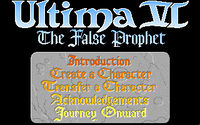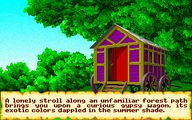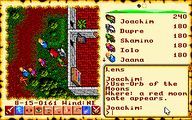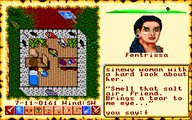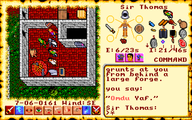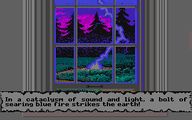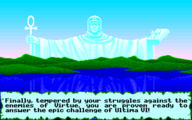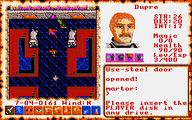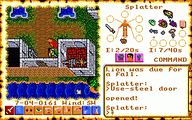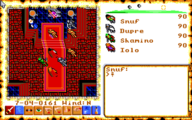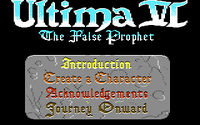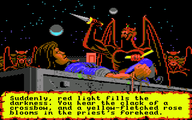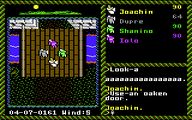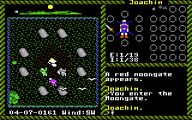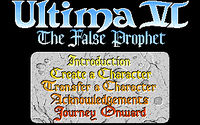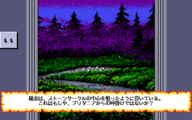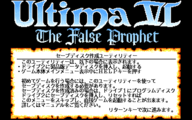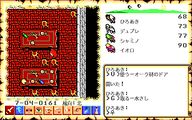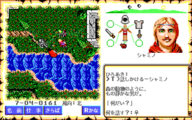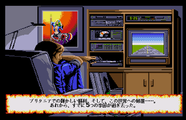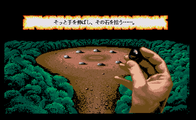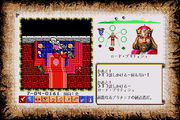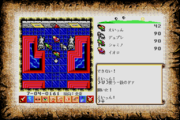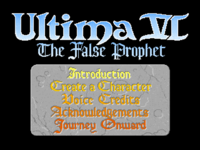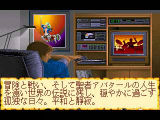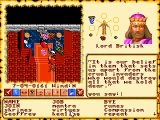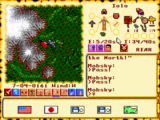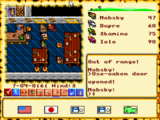Computer ports of Ultima VI
This article is about desktop computer ports of Ultima VI. For the Super Nintendo-port, see SNES-port of Ultima VI.
Ultima VI was the last game in the series to be ported to various systems. The gap between the ever-growing PC technology and the other systems started to become noticeable and caused Origin to make the decision to solely produce the games on the PC in the future.
Original Ports[edit]
The IBM PC Original[edit]
The original game for the first time was developed on a IBM PC, after development on the Apple II was scrapped. As far as is known, Richard Garriott tried to develop the game on the Apple II for almost a year, before giving up and switching development to the PC. This is very noticeable right away.
The game is much more detailed than its predecessors with everything being on a single-scale map. The graphics are now shown in 256-color VGA at a resolution of 320x200. It makes a huge difference, all the black of the previous installments has vanished from the screen and Britannia now looks more concrete. EGA and CGA modes are available as well.
Music is also a new feature. While previous installments on the PC did not have the music of the others ports, Ultima VI does. The AdLib card is supported, but so are high-end boards like Roland Sound. However, sound effects use the PC speaker.
Also the game is finally fully playable with the mouse and icon driven. The interface of Ultima VI is a lot more user-friendly than the previous ones, enabling even beginners to play the game. Only conversations still have to be typed manually and even that became easier with the colored marking of the keywords.
The game was retailed on either four 3.5" floppies or seven 5.25" floppies. While playing directly from the floppies was possible in theory, this resulted in constant disk-swapping; the game is clearly intended mainly for installation to, and play from, a hard disk.
The game will run on all 100% IBM compatible PCs with at least 512kb of RAM and an MS-DOS-compatible operating system, but to run it well, a roughly 10MHz CPU with VGA graphics and a sound card. On systems that are much faster than that, it will run too fast, ruining sound effects and making the player's motion around the landscape too fast to be usable, especially when the mouse is used for walking. This condition requires use of a slow-down program or an emulator like DOSBox.
IBM PC – Character creation
IBM PC – In Yew
The Amiga and Atari ST-Ports[edit]
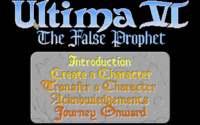
The Amiga and Atari ST-ports of Ultima VI were based on the PC original. By now the limitations of these two computer systems became obvious.
Since the Amiga 500 could only display a maximum of 32 colors at the same time and the Atari ST 16 colors, the VGA graphics simply could not be used. So they scaled down the VGA graphics to the palette of these two systems. While the result on the Amiga is pretty good for the platform, the Atari ST version is rather ugly with many color artifacts. This is especially noticeable in the introduction and the character portraits. On the Atari, the graphics also have a reddish tint that is rather distracting.
The sound-feature is another difference. The full soundtrack of the PC original was impossible to implement because of the strain the game put on computer power and floppy space. To compensate, the music was vastly reduced: some tracks such as the “Ultima Theme” or “Audchar Gargl Zenmur” were simply removed and other tracks were simplified beyond recognition, notably “Stones”. Composer Matt Furniss was tasked to rearrange the music for these ports.
The ports are both very slow on first-generation Amigas and Atari STs, since only meager reprogramming was done and the computers just cannot handle the engine, resulting in a game that essentially still would run better on a PC. When playing from disk, the game loads every step characters walk, at least on Amiga 500. Obviously, the game runs with a much better speed if used on a second- or third-generation machine, such as an Amiga 1200 or an Atari Falcon. Also, since the game ran on no less than four 3.5" floppy disks, frequent disk swapping is an issue – for instance, talking to an NPC requires swapping to the "populace" disk containing all dialogue. This issue could be resolved if the game is installed on a hard drive, for those Amiga and Atari ST users who owned one.
It should also be noted that the game has to be reinstalled from scratch (on floppy or HDD) whenever one wants to create a new character – a lengthy procedure.
The Amiga version also suffers from a critical bug that duplicates the party's inventory at random times. While this at first might look like a good thing for the player – as it copies useful items and gold – the rising number of items in the world slows down the game significantly. Especially since these items are all permanent.
Atari ST – Castle Britannia
The C64-Port[edit]
- Main article: C64-port of Ultima VI
The C64-port of Ultima VI, which is the only 8-bit port of the game, was published in 1991 – almost one year after the original release. The game was translated to the system by Axel of Imagitec Design due to time constraints at Origin. The sheer scope of the changes to the game, which exceeds this article, is shown in detail in a separate article.
C64 – In a moongate circle
Japanese-Only-Ports[edit]
The PC-98-Port[edit]
Roughly a year after the original, this port for the Japanese PC-98 system was released by PonyCanyon. Despite the name, this is a completely different computer system from the standard IBM PC.
While the resolution of the game was 640x400, only the Japanese writing and other text took advantage of this. None of the graphics were redrawn and instead simply scaled up for the new resolution. Also, since the PC-98 is only capable of displaying 16 colors at the same time, the EGA-palette of the original was converted, which makes it look similar to the ports on the Amiga and Atari ST.
The music of the port mostly sounds like a polished version of the Sound Blaster music of the original. Examples can be found on this site (sadly, all the file names are wrong, so it is trial and error to find out which tune is which).
The game was retailed on either two 3.5" floppies or two 5.25" floppies. However, it needed an extra save disk (the was no hard drive on the PC-98).
PC-98 – Talking with Shamino
The Sharp X68000-Port[edit]
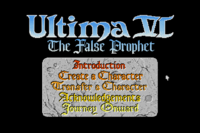
In 1992, this port for the Sharp X68000 was published by PonyCanyon.
While the port does have a different amount of colors than the one for the PC-9801, the graphics themselves are the same scale-ups from the original that the other port used. The one big graphical difference to the PC-9801 is the fact, that the game does use an even higher resolution at 768x512. However, instead of using this to store more screen content or redraw the graphics, the port simply creates a bigger and more elaborate background border, thus wasting the potential (strangely enough, the screen border is hi-res).
The game retailed on 3 5.25" floppy disks. Like with the PC-9801, a special save disk has to be created, as the game disks themselves do not allow for saving a game.
Sharp X68000 – Picking up the Orb of the Moons
Sharp X68000 – In conversation with Lord British
The FM Towns-Port[edit]
In most respects, the port of Ultima VI for the FM Towns system, released by Fujitsu, is a faithful replication of the PC original, with visuals and plot content translated intact. Nevertheless, there are some alterations and additions.
The game features two language modes: English and Japanese.
As on other Japanese platforms, here the game runs at a higher screen resolution (640x480) than its original form (320x200), and although the Japanese text takes advantage of the greater fidelity this affords, all other graphics are scaled such that their apparent resolution matches the PC version. The eighty extra lines of vertical resolution are occupied throughout active gameplay by icons for language modes and save/load functions, while dialogue options appear when conversing with characters.
Like its Super Nintendo-port, Ultima VI for the FM Towns features a conversation system that would soon be adopted by Ultima VII, whereby keywords can be selected from a list. However, the player still has the option of typing them.
Perhaps most notably, conversations are fully voiced in both English and Japanese (narration excepted). In the English mode, voices are provided by Origin employees, their family members, and friends, many characters with real-world counterparts being performed by the very same people upon whom they are modeled; for example, Richard Garriott features as Lord British and Shamino, Greg Dykes as Dupre, and David Shapiro as Dr. Cat. Although retained in the written dialogue, all references to the player's name and gender are avoided in these recordings. Voices will also reverberate slightly when heard within a dungeon.
While the music is largely unchanged (albeit somewhat higher pitched than the AdLib and Sound Blaster versions), sound effects are entirely recorded in higher quality. This includes all Words of Power spoken during spellcasting; the voice used is generic for all characters, however, with each incantation composed ad hoc from 26 individually recorded syllables.
As with the PC version, the FM Towns-port features no inherent CPU speed limiting, thus animations are prone to running faster than intended when emulated on modern systems. Music transitions (e.g. when entering combat, dungeons, or initiating a conversation) trigger a short pause, as the game waits for the current track to fade out before continuing.
Copy protection is omitted, as is the option for a character transfer from earlier installments, despite Ultima IV and Ultima V having previously been released for the FM Towns. A "Voice Credits" option appears in its place on the main menu.
The FM Towns-port included a full-color poster of Denis Loubet's cover art not found in other versions.
A complete playthrough of the FM Towns-port can be found here:
See Also[edit]
| Computer Ports | |
|---|---|
| Games | Ultima I ☥ Ultima II ☥ Ultima III ☥ Ultima IV ☥ Ultima V ☥ Ultima VI ☥ Savage Empire |
